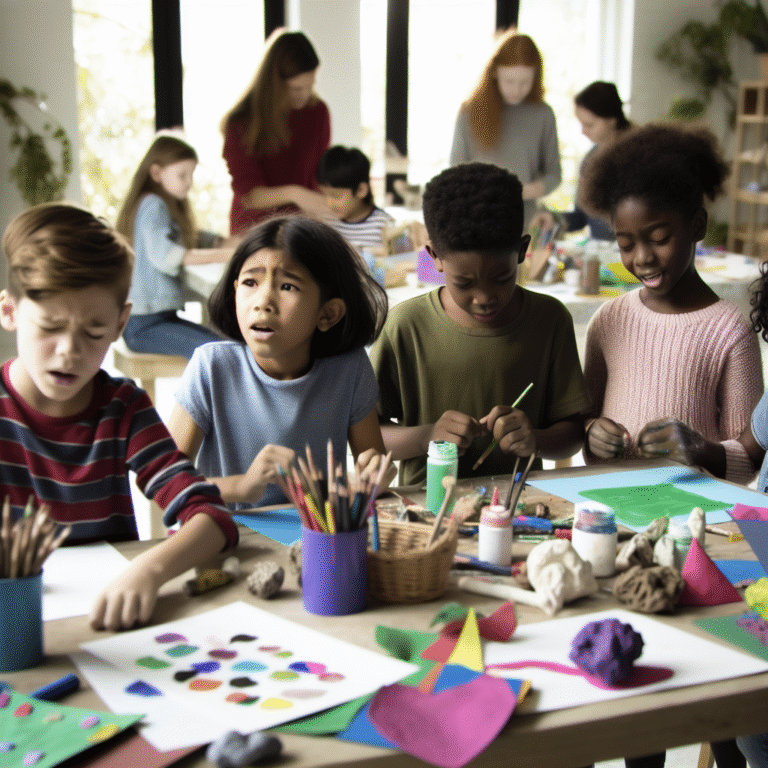
Navigating the Storm: Essential Emotional Regulation Techniques for Kids in Crisis
Introduction: Weathering the Storm Together
In today’s fast-paced world, children are increasingly exposed to emotional challenges that can affect their mental well-being. From academic pressures to social anxieties, the storms of life can feel overwhelming for little ones. This article, Navigating the Storm: Effective Emotional Regulation for Kids in Crisis, aims to shed light on practical strategies that parents, educators, and caregivers can use to help children develop emotional resilience. By understanding the importance of emotional regulation, we can equip kids with the tools they need to navigate their feelings and manage crises effectively.
Understanding Emotional Regulation in Children
What is Emotional Regulation?
Emotional regulation refers to the ability to monitor, evaluate, and modify emotional reactions in a manner that is socially acceptable and personally beneficial. For children, this skill is crucial as they navigate experiences that can lead to sadness, anger, frustration, or anxiety.
Why is Emotional Regulation Important?
Just as adults face various challenges in life, so do children. Developing strong emotional regulation skills can lead to better relationships, improved academic performance, and enhanced coping abilities. Emotional regulation is also linked to resilience, which allows children to bounce back from difficult situations.
Table 1: Benefits of Emotional Regulation for Kids
| Benefit | Description |
|---|---|
| Better Relationships | Kids who manage emotions tend to have healthier friendships. |
| Academic Success | Regulation skills help kids focus and perform better. |
| Coping Skills | Emotional regulation aids in coping with stress and anxiety. |
| Resilience | Kids become better at handling life’s challenges. |
Strategies for Navigating Emotional Storms
When discussing Navigating the Storm: Effective Emotional Regulation for Kids in Crisis, it is essential to offer actionable strategies that caregivers can implement. Below are some techniques designed to help children manage their emotions effectively.
1. Mindfulness Practices
Mindfulness involves being present in the moment and observing thoughts and feelings without judgment. Teaching children mindfulness can significantly enhance their emotional regulation skills.
Case Study: The Power of Mindfulness in Schools
A recent study in a group of elementary schools in California found that implementing a mindfulness program improved students’ ability to handle stress and emotional outbursts. Teachers reported a noticeable decrease in classroom disruptions and an increase in students’ focus.
2. Breathing Techniques
Breathing exercises can help children control their physiological response to emotions. Simple techniques like 4-7-8 breathing—inhale for 4 seconds, hold for 7, and exhale for 8—can calm an anxious child during a crisis.
Case Study: The Breathing Buddy Technique
A therapy group for kids experiencing anxiety introduced the "Breathing Buddy" technique, where children lay a stuffed animal on their stomach while practicing deep breathing. This not only made the process fun but also reinforced the physical sensations of calming down.
3. Emotional Vocabulary Development
Helping children articulate their emotions can be empowering. Use tools like emotion charts to introduce vocabulary related to feelings and explore what those emotions mean.
Table 2: Emotional Vocabulary Chart for Kids
| Emotion | Description | Example Situation |
|---|---|---|
| Happy | A feeling of joy | Having a great day at school. |
| Sad | A feeling of loss | Losing a favorite toy. |
| Frustrated | Feeling unable to achieve something | Struggling with math homework. |
| Angry | A strong feeling of displeasure | Arguing with a friend. |
| Anxious | A feeling of worry | Feeling nervous before a big test. |
4. Create a "Feelings Menu"
A "Feelings Menu" allows children to choose their current emotional state from a list of expressions. This visual representation can be especially helpful when they struggle to verbalize feelings during a crisis.
5. Role-Playing Scenarios
Engaging kids in role-playing can enable them to practice emotional regulation in a safe space. Parents can model different scenarios and provide feedback, which allows children to rehearse responses to challenging situations.
Case Study: Role-Playing in Therapy
In a clinical setting, a child facing bullying was guided through role-playing exercises with a therapist. The child practiced assertiveness and learned to express feelings without aggression. This technique proved effective in real-world situations, leading to improved interactions on the playground.
Building Supportive Environments
Creating Emotional Safe Spaces
A fundamental aspect of Navigating the Storm: Effective Emotional Regulation for Kids in Crisis is establishing an emotionally safe environment. Caregivers and educators must create spaces where children feel secure enough to express their feelings openly.
Actions to Consider:
- Establish routine check-ins to gauge emotional well-being.
- Ensure accessible resources for emotional support, such as helplines or counseling services.
- Promote an open dialogue about feelings and emotional health.
The Role of Positive Reinforcement
Reinforcing emotional expression positively helps normalize discussions around feelings. Celebrate when your child successfully carries out emotional regulation techniques, fostering a sense of accomplishment.
Teaching Problem-Solving Skills
Emotional regulation is closely linked to problem-solving abilities. When children encounter challenges, teaching them to approach these situations effectively can help them manage their emotions and frustrations better.
Encouraging Critical Thinking
Encourage children to think critically about their emotions and the problems they face. Ask questions that prompt them to explore different solutions:
- What other ways could you handle this situation?
- How did you feel, and what could you do differently next time?
Case Study: Problem-Solving Workshops
A nonprofit organization offered problem-solving workshops for children dealing with bullying. By using guided questions and activities, children learned not only to control their emotions but also to find constructive solutions to their problems.
The Importance of Parental Involvement
Being a Role Model
Children learn by watching the adults in their lives. Modeling healthy emotional regulation behavior can have a profound impact on their development. Practicing your own regulation techniques—such as deep breathing or discussing your feelings—can inspire your children to do the same.
Open Communication
Maintain open lines of communication with your child. Encourage them to speak freely about their emotions without the fear of judgment. By fostering a safe space for discussion, you empower them to take charge of their emotional health.
Conclusion: Moving Forward with Confidence
Emotional regulation is a vital skill for kids facing various life challenges. By implementing the strategies outlined in this article, we can help children learn to navigate their emotional storms effectively. Remember, Navigating the Storm: Effective Emotional Regulation for Kids in Crisis isn’t just about teaching techniques—it’s about fostering an environment where children feel safe, understood, and capable of managing their emotions.
As we encourage our children to explore their feelings and practice emotional regulation, we equip them with essential life skills that will serve them well into adulthood. With the right tools, love, and support, our children can emerge from their storms not just intact, but stronger and more resilient.
FAQs
1. What are the signs my child is struggling with emotional regulation?
Common signs include excessive mood swings, difficulty concentrating, and frequent outbursts of anger or sadness. If you notice these behaviors, consider seeking guidance from a mental health professional.
2. How can I teach my child emotional regulation at home?
Use techniques such as mindfulness activities, breathing exercises, and open dialogues about feelings. Encourage your child to express their emotions freely and offer positive reinforcement when they do.
3. Can emotional regulation skills be taught to younger children?
Absolutely! Younger children can benefit from simple techniques like deep breathing, using visual emotion charts, and storytelling to explore feelings in a relatable way.
4. What should I avoid when helping my child with emotional regulation?
Avoid dismissing their feelings, using punitive measures for emotional outbursts, or showing frustration when they struggle. Instead, model understanding and empathy.
5. Where can I find additional resources for emotional regulation?
Consider exploring books, parenting blogs, workshops, and online courses that focus on emotional intelligence and regulation techniques for children. Many schools now offer programs focused on emotional well-being as well.
By taking action and prioritizing emotional regulation, we can help today’s children successfully navigate the storms of life, preparing them for a bright and fulfilling future.















